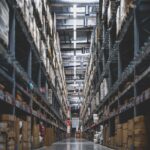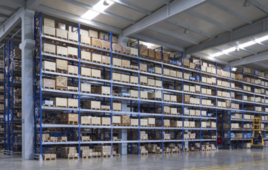A Q&A with Optimas Solutions’ CEO…
Even at the best of times, monitoring one’s supply chain against changing market conditions and emerging risks, can be a daunting task. Add in geo-political or economic disruptions (or say, a global pandemic) and that task can go from daunting to chaotic overnight.

A supervisor monitors cold heading manufacturing at Optimas’ Wood Dale, IL facility. The design of the company’s new Monterrey, Mexico manufacturing facility will be modeled after the one in Wood Dale, drawing heavily on proven processes used there.
Certainly, the pandemic exposed the vulnerabilities of offshore manufacturing and supply chain practices. What’s resulted for many over the past few years has been a re-thinking and “reshoring” of those practices.
In fact, UBS examined the reshoring trend when the bank polled more than 1,600 executives earlier this year. It showed that many senior executives in different sectors surveyed by the bank intended to move parts of the supply chain closer to home — 78% in Europe, 70% in the U.S., and 54% in China plan to do so, according to research published earlier this year.
Manufacturers are responding accordingly, but many are challenged by exactly how they pivot to this new approach and what it takes to get it done. For clarity, we had the honor of speaking with Daniel Harms, CEO of Optimas Solutions, a global industrial manufacturer, distributor, and service provider.
Optimas recently announced one strategy intended to strengthen its global supply chain. The company is opening a cold-form manufacturing plant in Monterrey, Mexico in the second half of 2024. The Mexico production center will complement its U.S. fastener manufacturing facility in Wood Dale, Illinois — continuing the company’s nearshoring efforts to minimize supply chain risk.
Here, Daniel Harms explains the advantages of nearshoring, and provides insight on best practices and digitalization.
Fastener Engineering (FE): Congratulations on the new manufacturing facility, Daniel! I’m sure you’re looking forward to its official opening. And I hope you can share some insight with us on nearshoring versus onshoring, and how one or the other can impact an organization’s supply chain?
Daniel Harms (DH): Of course! Thank you. Onshoring and nearshoring are quite nuanced versions of similar strategies. There are unique reasons why one makes sense over the other, but typically it’s a blended strategy that strengthens the supply chain and provides resiliency. Both relate to proximity to one’s customer.
Onshoring is about close proximity, and moving or keeping products as close to the same city, state, or country as one’s target market. So, it’s locating operations or manufacturing processes within the same national borders as one’s headquarters or home base.
Nearshoring is similar, bringing products closer to one’s home base or target market in comparison to offshoring. However, it’s not in the exact region or vicinity of the customer base. With nearshoring, companies move their manufactured products to a more cost-effective region that’s not directly in their state or country — but close. There are benefits to bringing one’s supply chain closer to home. But most global manufacturers will balance both nearshoring and onshoring options.
FE: Have you noticed a renewed interest or strategy with companies focusing on “reshoring” their supply chain?
DH: There’s definitely been a re-evaluation of supply chains over the last few years. I hate to reference the pandemic at this point, but it is clear that it led to a much more interconnected supply chain, locally and globally. It really exposed the fragility of the global supply chain.
It also showed how precarious it can be to rely solely on an offshore supply chain or a single source for parts or products. And it’s not just a pandemic that can do this. Today, there are geopolitical issues that can expose the same risks. This is where a balanced and diverse supply chain can offer significant advantages.
Of course, as imperative as diversity is in today’s manufacturing world, let’s not discount the value of ‘Made in the USA’ — this is something we take pride in as we have our largest and most productive manufacturing site located in the U.S. But when it comes to serving and supplying to customers, it’s also essential to provide that service, without interruption, at an ideal cost balance.
FE: What are some of the challenges that arise when making supply chain decisions, particularly related to assessing an ideal source or location for materials and manufacturing?
DH: I think it’s incredibly important to assess one’s own values and business structure. Ultimately, this decision is personal for a company and has to be about what works best for that organization’s value system, supply chain, and customers.
For us, it’s very much about dependability, quality, and value for the cost. These are ideals most OEMs, distributors, or manufacturers grapple with, at least to some extent every day. To provide our best, we evaluated what locations made sense to meet these goals as part of a multi-year strategy.
Also, we think one’s values or ethics as a company are extremely important in making these decisions. As a global company, we spend a lot of time on cultural diversity, distinguishing Optimas from many other companies that I’ve worked at before. We think diversity is an enormous strength that not only benefits our team but also our customers.
So, challenges are bound to arise, but it’s easier to respond to them when you’re clear on your organization’s goals, structure, and values.

Click here for 11 questions to consider for minimizing supply chain risks.
FE: What are a few best practices when transitioning or relocating one’s supply chain?
DH: In terms of reshoring decisions, it can certainly be daunting. So, I’d suggest addressing it in steps or stages. For one, you’ll want to just consider history. The pandemic was a big one, but historically, there are always some periods of instability — which could lead to supply chain disruptions. So, how do you find solutions or resiliency in your supply chain in preparation for those future uncertain times?
Secondly, bear in mind that there is a risk-reward value to all supply chain choices, right? As you contemplate resiliency with costs, the pendulum may swing one way or the other. So, find the balance… or the closest thing to it that ensures as much reliability, security, and cost-effectiveness as possible.
A third factor that helps is having the right partners when making supply change transitions. There are characteristics to consider as you evaluate partners that should include their background and current values. If one partner doesn’t pan out, there are others. Find people you trust.
FE: Should digitalization come into play when considering one’s supply chain?
DH: Definitely! We’ve seen this big movement in digitalization and supply chains over the last five years. Data-driven decisions are essential today in making objective decisions.
I think sometimes the supply chain can be an emotional field. There’s this idea that one’s only as good as the last order shipped. Although there might be an emotional tie to a particular product family or service, raw data is critical to making relevant decisions.
Whether nearshoring, onshoring, or offshoring, better information and datasets lead to better decisions. However, it’s also incredibly important to know how to use that data correctly to add value to one’s organization. And this can be a journey. But the end result can be so impactful. What used to be a 10,000-line spreadsheet, can now become streamlined into concrete trends and results with the right data and analysis.
Add in machine learning and it’s also possible to better quantify risks, which is a big thing for the supply chain. Ultimately, this is about moving from reactive to proactive, and for a supply chain that’s everything.
Lastly, I want to mention how digitalization can lead to better communication and transparency. We talk a lot about data internally, but it’s also essential when working with suppliers and customers to ensure everyone has end-to-end visibility of your supply chain.
FE: Are there other factors to consider in relation to “reshoring” or making critical supply chain decisions?
DH: Yes… probably one largest unspoken benefits of nearshoring we haven’t touched on yet is the inherent sustainability advantages. By moving the supply chain closer to home, one’s reducing their carbon emissions. So, it’s one major advantage over offshoring that can potentially help organizations meet some of their sustainability goals.
We published our first sustainability report this year, and it’s one of those transparency issues customers are now demanding, which is incredibly important for a supply chain and an environmental aspect.
Reshoring is a big decision, but one that might be critical to your supply chain. This decision should ideally be made with reliable data and partners you trust.










Tell Us What You Think!